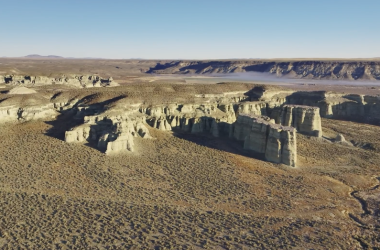
Americold, the billion-dollar company based in Atlanta, Georgia, has a sprawling network of 137 temperature-controlled warehouses, including one in Ontario and also contracts to manage other warehouses. (The Enterprise/Joe Siess)
NYSSA – Concern was evident in the email message last December to the onion executive leading the Treasure Valley Reload Center project.
“It is imperative that we begin to round up shipper commitments,” wrote Greg Smith, Malheur County’s economic development director.
The message was to Grant Kitamura, a partner in one of the area’s largest onion processing firms and president of the county-created Malheur County Development Corp.
There was good reason for Smith’s urgent tone.
The fate of nearly $26 million in state funding for the Nyssa shipping center hinges in part on Smith and his crew getting a private operator in place run the center. The state is insisting Malheur County establish that the project makes financial sense before it will release most of the money.
But three years after the idea of Treasure Valley Reload Center took hold as a way to help Malheur County’s onion industry, Smith still can’t establish how much of the region’s 490,000 tons of shipped onions would flow across the new dock in Nyssa.
Nearly two months after his message to Kitamura, Smith again prodded the development board.
“We really need to nail down what is going to be the volume and destinations,” Smith told his board last week.
Here’s why.
Onion shippers want to cut their shipping costs and presumably boost profits.
Now, they use a combination of trucks and rail cars to move Malheur County’s onions.
The shipping center holds the promise of faster transport at lower costs.
Those lower costs depend on whether Union Pacific Railroad and Americold, the company favored to run the terminal, can offer shipping rates that beat what onion processors now pay.
But the railroad and Americold can’t calculate that price without knowing how many tons of onions would shift from truck to rail and where in the country they would end up.
In the end, everyone has to make money or the project won’t pencil out.
This isn’t a new issue, but the continuing uncertainty could mean the project doesn’t rise out of the Nyssa farm field as fast as expected.
Last year, Smith proclaimed onions would be moving out of Nyssa’s new depot by this fall.
Now, the county forecasts that won’t happen for another two years.
The immediate pressure is getting the terminal operator locked in place.
[ KEEP YOUR LOCAL NEWS STRONG – SUBSCRIBE ]
A year ago, consultants warned the state Transportation Department and Malheur County officials that an agreement with a company to run the Nyssa operation was “essential to project viability.”
In October, the county agreed that would be one of the first tasks done to satisfy the state that it was ready to move on to more expensive stages of the project. At the time, the county said an operator would be signed up by Dec. 16.
As public records subsequently revealed, the county was nowhere close to a deal by that date and still isn’t today.
Revealing records
For nearly a year, Smith and his team have worked toward a deal with Americold.
The billion-dollar company based in Atlanta, Georgia, has a sprawling network of 137 temperature-controlled warehouses, including one in Ontario, and also contracts to manage other companies’ warehouses.
It’s the only company that responded to Malheur County’s invitation to try for the Nyssa operation.
Last April, Malheur County published an elaborate “letter of interest request,” a variation of the request for proposals typically used to check interest and qualifications for public projects.

Greg Smith, Malheur County’s economic development director, speaking to county commissioners at the Malheur County Courthouse in December.
At the time, an Americold manager from Ontario had a voting seat on the county’s development board, and records show Smith was talking with a company executive days before the deadline for the “letter of interest.”
Americold subsequently submitted a three-page letter declaring its willingness to negotiate a lease to run the Treasure Valley Reload Center.
In January, the Enterprise requested the county disclose all the responses to that request for a letter of interest, in part to determine if there were competing offers.
Smith wouldn’t release those records and in January brought in an Ontario lawyer, Brian DiFonzo of Yturri Rose, to fend off the newspaper’s petition seeking the documents.
Under state law, such records disputes go to District Attorney Dave Goldthorpe to decide whether public documents are released or withheld.
In a letter to Goldthorpe, DiFonzo argued that releasing the 47 pages of material would crimp the county’s ability to drive an advantageous bargain with Americold.
He said the records should be kept away from the public under a law intended to prevent “contractors from learning the content of competitors’ proposals.” DiFonzo said the law allows an agency to avoid disclosing information to “competing proposers.”
Goldthorpe allowed the county agency to keep nine pages confidential but ordered another 36 pages released.
They showed that the county had only one letter of interest, from Americold.
There was no record released showing any “competing proposers.”
But that wasn’t because no one else wanted in on Nyssa.
Railroad tries to connect
When legislators in mid-2017 set aside $26 million for the Nyssa project, the owners of Oregon Eastern Railroad swung into action.
By Smith’s own account, he met one time that summer with the railroad executives.
In response to a recent public records request, Smith turned over a staff note showing that one topic of that meeting on July 19, 2017, was to “update the short line on the reload project and ask if there is anything the short line can provide to the project.”
“The project was explained to them. A due date for submittal was given to them. Thereafter, our office never received their submittal, or even further correspondence. It was incumbent upon their entity to provide a proposal, which was not done,” Smith said in a recent letter to the Enterprise.
Smith’s letter is confusing. His meeting with those railroad officials came just 10 days after the Legislature approved the money and before the governor signed the appropriation into law. The county had yet to define its project – or even pick the location – when Smith sat down with the railroad executives.
Last week, Smith said his agency had no records showing any requirement for a “submittal” or a “due date” as he had described. He said the requirements given to Oregon Eastern Railroad relating to the $26 million project were “completed verbally.”
Railroad officials provided email records that contradict Smith’s account he had “never” received additional correspondence from them.
Two days after that July 2017 meeting, a railroad official sent Smith an email, thanking him for the meeting. Smith messaged, “I will be keeping you in the loop as we move forward on the reload project.”
About a month later, Oregon Eastern Railroad provided information on a site on its line just off the Union Pacific Railroad line running from Ontario to Nyssa.
“The cost to build an interchange for a new facility would be extremely expensive if the facility was located on UP. Also, as a short line we would provide outstanding switching service for the new transload operation,” The Western Group, the railroad’s parent company, told Smith in an email.
“The property is one of the sites we had listed as a potential location,” Smith responded the same day. “However, your additional information is very valuable.”
After that, railroad officials said, they could never reach Smith. Railroad officials learned from newspaper accounts, not Smith, that Nyssa had been picked to host the shipping center.
The officials fumed to each other about Smith, with one noting the announcement “now explains why he did not return my calls.”
A Western Group email on Dec. 18, 2017, recounted its effort to be part of the Malheur County project.
“We were supposed to be invited to meetings to tour the sites with UP and this did not happen,” the email said. “We followed up with Greg outlining property in Ontario on our line that could be used for the transload and he acknowledged that info and indicated it would be included in the process. I left numerous voice mail messages for him and never received a return call.”
A railroad manager from Vale said he tried to find Smith too but the county’s office in Ontario “was empty the few times I could stop in.”
Meantime, another railroad company had managed to get Smith’s attention and seemed to stake a place at the front of the line for consideration as the operator of the Nyssa terminal.
For Eyal Shapira, president of Raritan Central Railway in New Jersey, the Nyssa project fit well with what his company already does.
Raritan operates rail loading facilities and ships rail loads from the west back east, primarily lumber.
In December 2017, he wrote to Smith.
“We have strong interest in operating the proposed cross dock facility” in Nyssa, Shapira wrote. He noted that “more than 40% of onions and potatoes shipped from Oregon, Washington and Idaho are destined to our market area.”
Malheur County counted on that letter not once but twice to bolster its claim to the state’s $26 million. The Raritan letter went to state transportation officials in December 2017 and again in September 2018, when the county gave the state its most detailed plans for the Treasure Valley Reload Center. The Raritan letter was prominently featured near the beginning of the lengthy submission.
Americold, in contrast, wasn’t on the submission to the state listing local businesses backing the project.
When it came time to advance on a contract to run the terminal, Oregon Eastern Railroad and Raritan were left out.
“We didn’t know we had to file a letter of interest,” Shapira said in a recent interview.
And at Oregon Eastern Railroad’s parent company, executives recently reviewed the “letter of interest request” the county had published in Ontario. None had ever seen it, they said.
Smith didn’t respond to written questions about the matter.
A big file
Though Americold seemed to have the inside track, Smith still had trouble getting the company to the table.
With the state deadline looming, Smith tried to get Americold to Nyssa to meet with onion producers and tour the site. He proposed a tour in August, but Americold’s lead executive on the Nyssa project said he’d be in Seattle then. A visit in September got canceled when the executive said he had to travel to Americold’s headquarters in Atlanta.
Doug Olmstead, Americold’s senior director of business development, finally scheduled a visit to Nyssa for October.
Smith in an email told Olmstead that after the tour, they would meet in Ontario for “preliminary discussions” on a deal. “We look forward to this beginning discussion in a long partnership with Americold,” he wrote.
Smith struggled to get the information that Americold needed for deciding whether to proceed on the Nyssa project.
Olmstead wanted to get back a company-provided form filled out with essential information for Americold.
That’s not what he got.
 John Braese of the Malheur County Economic Development Department. (Enterprise/file)
John Braese of the Malheur County Economic Development Department. (Enterprise/file)
In December, John Braese, an aide to Smith, emailed a 457-page document to Olmstead.
The Americold executive messaged that the file was “blowing up” his email program and he couldn’t forward it. He asked about getting the one-page form.
Smith stepped in that same day, trying round it up. He reached out to the firm being paid by the county to handle financial and economic research on the Nyssa project.
“We need that one page immediately as Americold is requesting it ASAP,” Smith wrote in a Dec. 18 message to Adam Domanski, senior economist with ECONorthwest in Seattle.
Domanski didn’t have good news in his response.
He said ECONorthwest indeed had the form but had plugged in the wrong information for Americold on the volume of onions that would move through Nyssa. ECONorthwest had listed the entire volume of onions grown in the region – not the share that would move by rail. The number was useless to Americold.
Domanski acknowledged that this was “the key information Americold is looking for.”
He told Smith that ECONorthwest could instead use its earlier estimates of what would move by rail but cautioned that a state consultant already had considered that figure “generous.”
Domanski said what his team really needed to calculate the volume was “shipper commitments.”
He concluded by saying that if Smith just had to get a number to Americold, ECONorthwest could provide the figure already questioned by the state’s consultant.
In an email last week to the Enterprise, Domanski said, “We provided the best estimate possible given the data and time made available to us.”
On Jan. 6, Olmstead sent an early morning email to Smith.
He needed that one-page document – now. He had a meeting the next day at corporate headquarters on the Nyssa project, he told Smith by email.
“The document was finished up this weekend,” Smith responded, sending it along.
Americold executives in Atlanta then provided only “preliminary approval” for the Nyssa project.
In mid-November, the county reported it had 65% of the work done on the contract with Americold. But four days before the Dec. 16 target to get the contract signed, the county said it needed more time, projecting a final deal by Feb. 15, but assured the state that “discussions with the proposed operator are moving quickly.”
By Feb. 7, the county reported that it was 70% done with a deal but another month was needed. Again, Malheur County assured state officials that matters were moving ahead and the terminal operator agreement would be done by March 15.
“A large meeting with the proposed operator and Union Pacific is scheduled for February 14 with a large amount of progress expected due to level of individuals on the call. This one call should provide excellent status of negotiations with operator and expected time frames for agreement,” he wrote.
But days later, Smith was alerting the development company board the final numbers still weren’t available.
The following week – on Feb. 25 – the development board heard that yet another survey of onion shippers was underway to get the figures needed by Americold and Union Pacific.
Asked during that meeting what was the new date projected for closing the deal with Americold, Smith declined to answer.
Reporter Pat Caldwell contributed to this story. Contact [email protected] or [email protected].
For the latest news, follow the Enterprise on Facebook and Twitter.
SUBSCRIBE TO HELP PRODUCE VITAL REPORTING — For $5 a month, you get breaking news alerts, emailed newsletters and around-the-clock access to our stories. We depend on subscribers to pay for in-depth, accurate news produced by a professional and highly trained staff. Help us grow and get better with your subscription. Sign up HERE.




